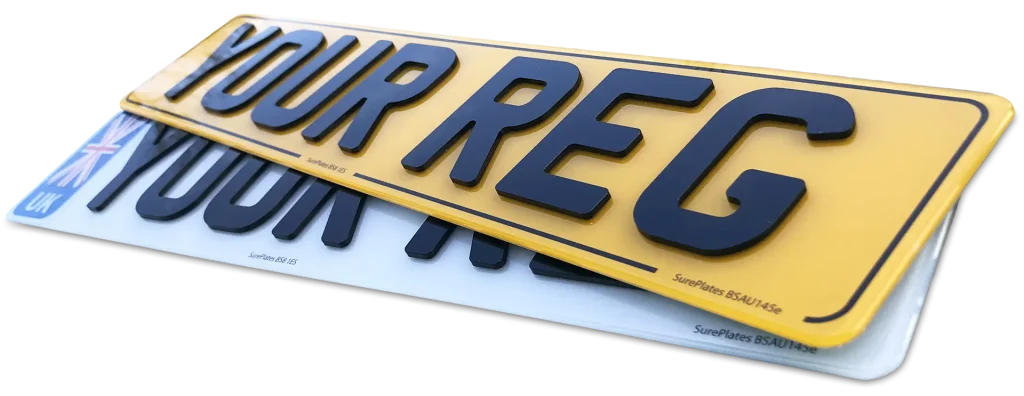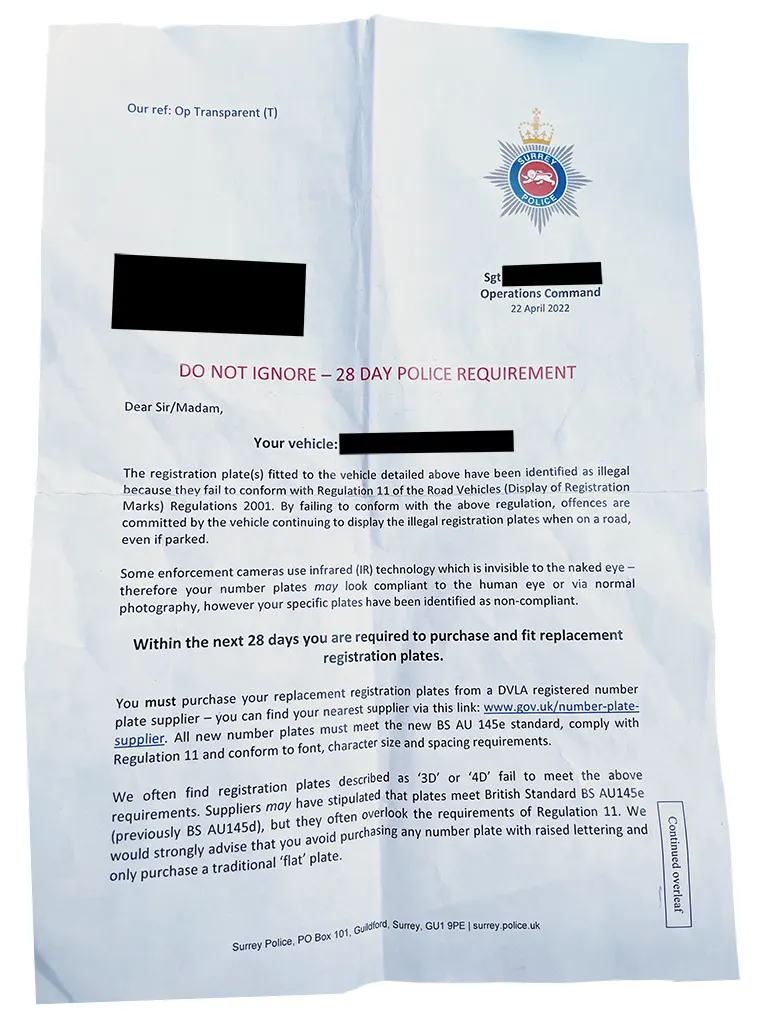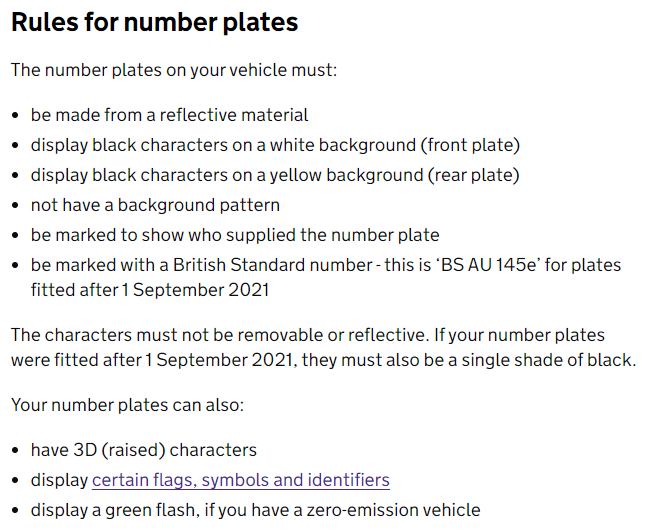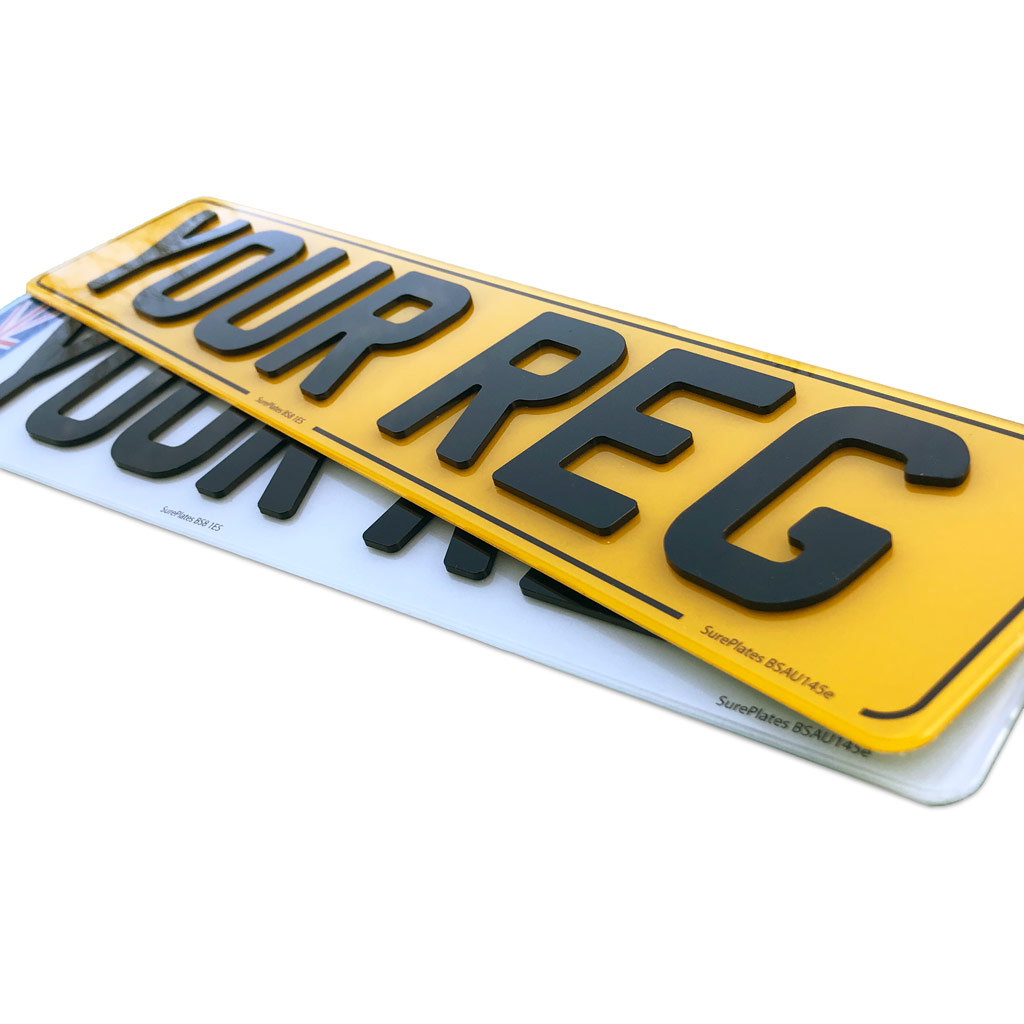With the rate at which drivers in the UK are buying 3D number plates today, the question of whether 3D plates are road legal comes up often. The most significant changes to regulations came in September 2021 when the British standard was updated to its current version: BS AU 145e:2018.
Some police forces are issuing fines for people displaying these number plates, giving people the mistaken impression that all 3D number plates are illegal. This certainly isn’t the case, but if they’re road legal, why are people receiving orders from the police to remove them?
So are 3D plates road legal? Here’s what the law says
Number plates are regulated by The Road Vehicles (Display of Registration Marks) Regulations 2001.
This statutory instrument isn’t very long, and the regulations for the characters aren’t very detailed either. The rules simply say the characters must be black.
Where the registration mark is displayed on the front of the vehicle, it must have black characters on a white background.
Where the registration mark is displayed on the back of the vehicle, it must have black characters on a yellow background.
https://www.legislation.gov.uk/uksi/2001/561/schedule/2/made
In the above regulations, compliance with the current British standard is required. The British standard is a specification for the technical requirements of a number plate. Things like how reflective they should be, luminance levels for characters, resistance to bending/heat/cold, etc. Mostly boring stuff.
However, the wording of the standard is equally simple when it comes to characters. Section 5.2 Characters says:
The complete surface of each registration character shall be one shade of black
BS AU 145e:2018 5.2 Characters, 5.2.2
There are some other requirements for characters. These include the following:
- Width & height of digits of 79 mm x 50 mm
- Space between digits of 11 mm
- Gap of 33 mm between character groups
- Margin around the outside of the whole registration number of 11 mm
Provided a typical set of 3D plates complies with these other rules, the answer seems straight forward.
3D plates meet the regulations, and are therefore road legal.

What changed for number plates in September 2021?
The major revisions of the British standard in 2021 include the following:
Black font only
All plates manufactured after September 2021 must display black characters. This is to make it easier for automatic number plate recognition systems to recognise a vehicle.
Plate markings
Number plates can no longer display logos, website address, or telephone numbers where the supplier details are printed. The plate markings may only display the supplier’s name & postcode and the British standard.
Other revisions
There were quite a few other changes to the latest British standard, but most focussed on technical specifications such as thermal resistance, weathering, bending/cracking, etc.
What about regulation 11 and Surrey police?
Regulation 11 has been used by various police forces, including Surrey police force, to argue that 3D plates are not road legal. Surrey police have even sent out threatening letters ordering people to remove their 3D plates.

Broadly speaking, regulation 11 says you cannot make a number plate more difficult to read by treating it in certain ways. For example, you cannot apply any material or chemical to the characters to make them reflective.
You also cannot make the characters less easily distinguishable to the eye, a camera device, or “any other device”.
Furthermore, you can’t place a screw or bolt on a plate in a way that changes the appearance of the characters. For example, putting a screw between ’11’ to make it look like an ‘H’.
Some police forces have argued that 3D characters are unreadable by their ANPR cameras. In those specific instances, they say those specific plates were illegal. They are not arguing that all 3D number plates are illegal.
This is important to recognise, as any number plate can potentially fail to read given the right conditions, and would therefore be illegal. There’s no reason to pick on 3D plates unless a pattern of non-readability emerges.
Can ANPR cameras read 3D plates?
ANPR means Automatic Number Plate Recognition. An ANPR system combines a camera with software to ‘automatically’ read your number plate and do something with the data.
Any camera can become an ANPR camera, and ANPR systems are not standardised.

Most cameras used in public ANPR systems (such as speed cameras or bus lane cameras) have both daytime and night time (infrared) modes for 24/7 monitoring.
Companies & organisations are free to implement their own ANPR systems or use readily available ones, so it’s difficult to get a clear understanding of why some may not be reading 3D digits.
Car park cameras are sometimes mounted at severe angles, which could in theory make it more difficult to read a number if the software is calibrated for printed digits.
We have conducted our own extensive testing using off-the-shelf ANPR software with standard, basic cameras and found 3D number plates to be as readable as standard printed plates. We’re going to publish these results soon.
DVLA tacitly agrees that 3D plates are road legal
DVLA have reversed their opinion on 3D plates several times over the last few years, but they now agree that 3D plates comply with the rules. In a newsletter to registered number plate suppliers, DVLA tacitly confirms suppliers may supply 3D gel and 3D number plates.
The organisation unfortunately will not explicitly state that 3D plates are road legal, despite all the evidence that they are. They instead simply say that 3D gel and 3D number plates must be able to comply with the British standard and the law. They say:
On number plates with raised characters, including 3D gel and 3D number plates, the entire number plate must be able to fully comply with both the standard and legal requirements. This also includes the characters of the registration number.
https://content.govdelivery.com/accounts/UKDVLA/bulletins/2e3e7b6
It is important to note that this newsletter is not the law. We assume DVLA has a legal department checking public newsletters for accuracy before they are published.
Parliament shares their opinion on the matter
On 19 January 2021, a petition was created on petition.parliament.uk. The premise of the petition was actually wrong, but the answer was good for number plate makers like us. The petition was titled “Stop the ban of 4D and 3D registration plates”. As they were never banned to begin with, the petition wasn’t really needed.
The government responded directly because the petition received over 10,000 signatures. In the response, the government stated the following:
The new British Standard for retroreflective number plates does not state that number plates with raised characters, including 3D gel and 4D number plates, will not be permitted
petition.parliament.uk/petitions/569318
They go on to echo the sentiments of DVLA by explaining that number plates must comply with the British standard and the law.
GOV.UK tells us number plates can have raised digits
At the time of writing (27-August-2022), GOV.UK’s page on displaying number plates confirms that number plates can have 3D (raised) characters:

Conclusion
All the evidence available tells us that 3D number plates are road legal. They are in compliance with the regulations and the British standard.
They are readable by ANPR systems. DVLA and the government tacitly agree that 3D plates may be supplied as long as they meet the legislation and the British standard.
When buying your 3D plates, make sure you use a reputable supplier who has registered with DVLA. You can check the register of number plate suppliers here.
